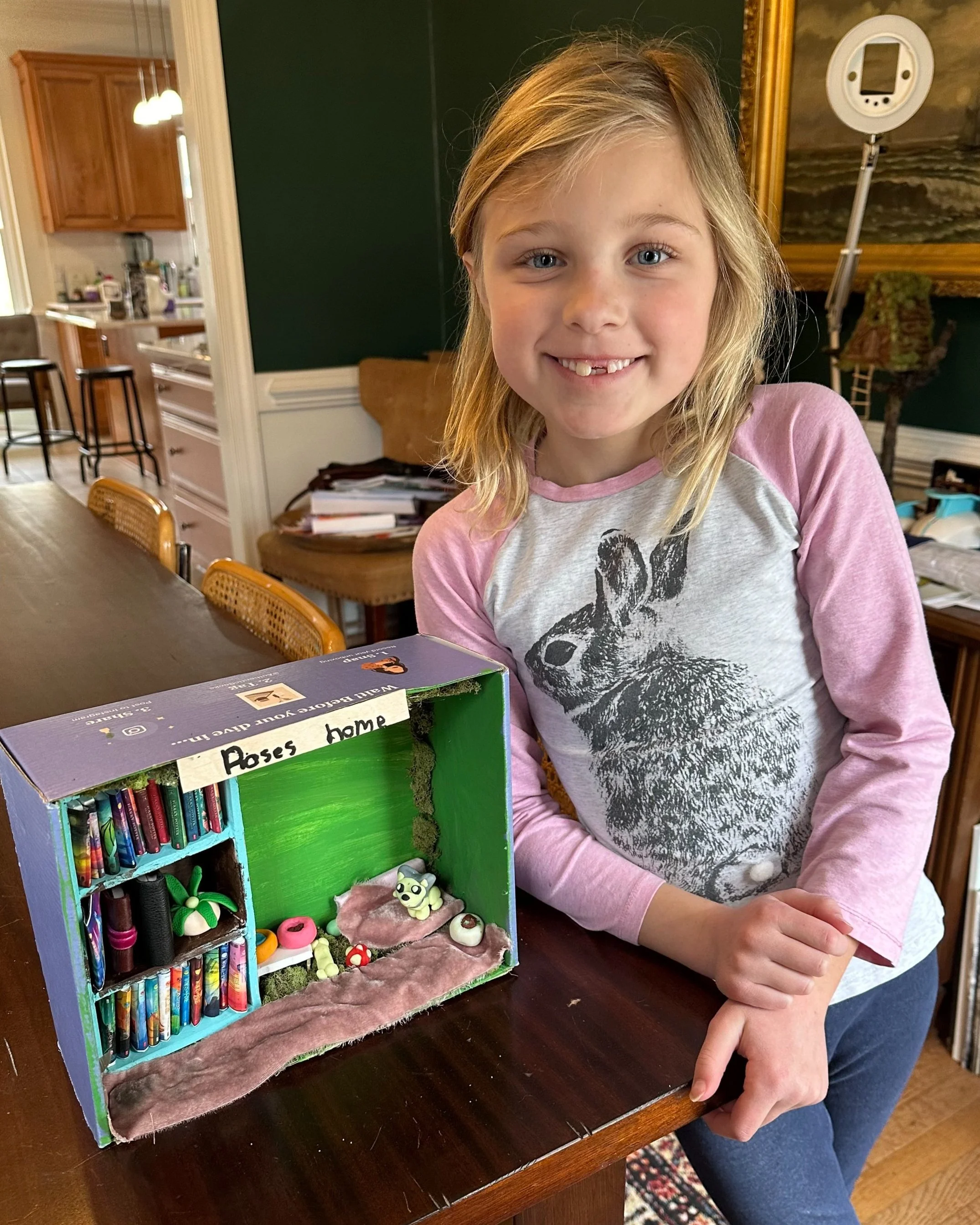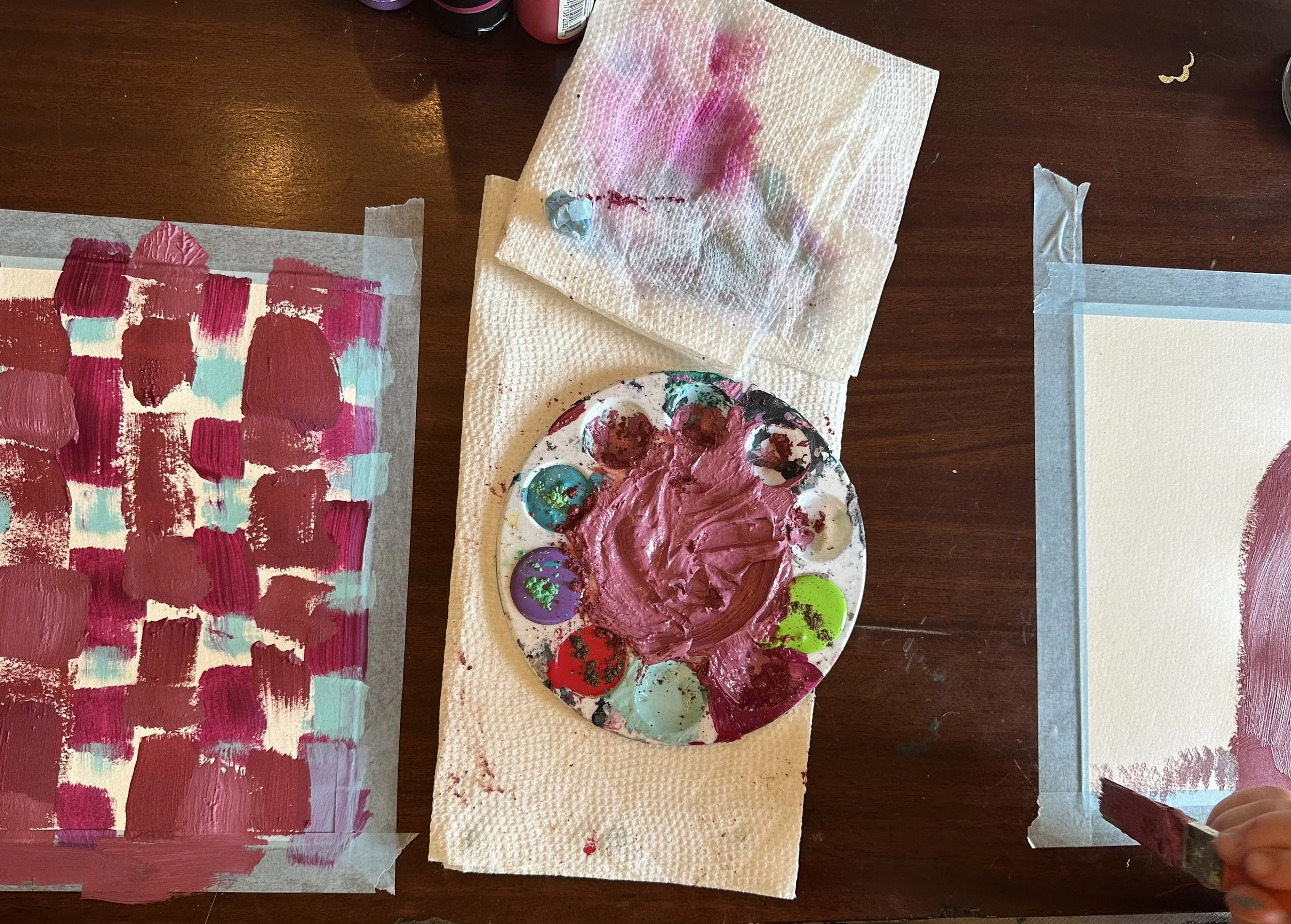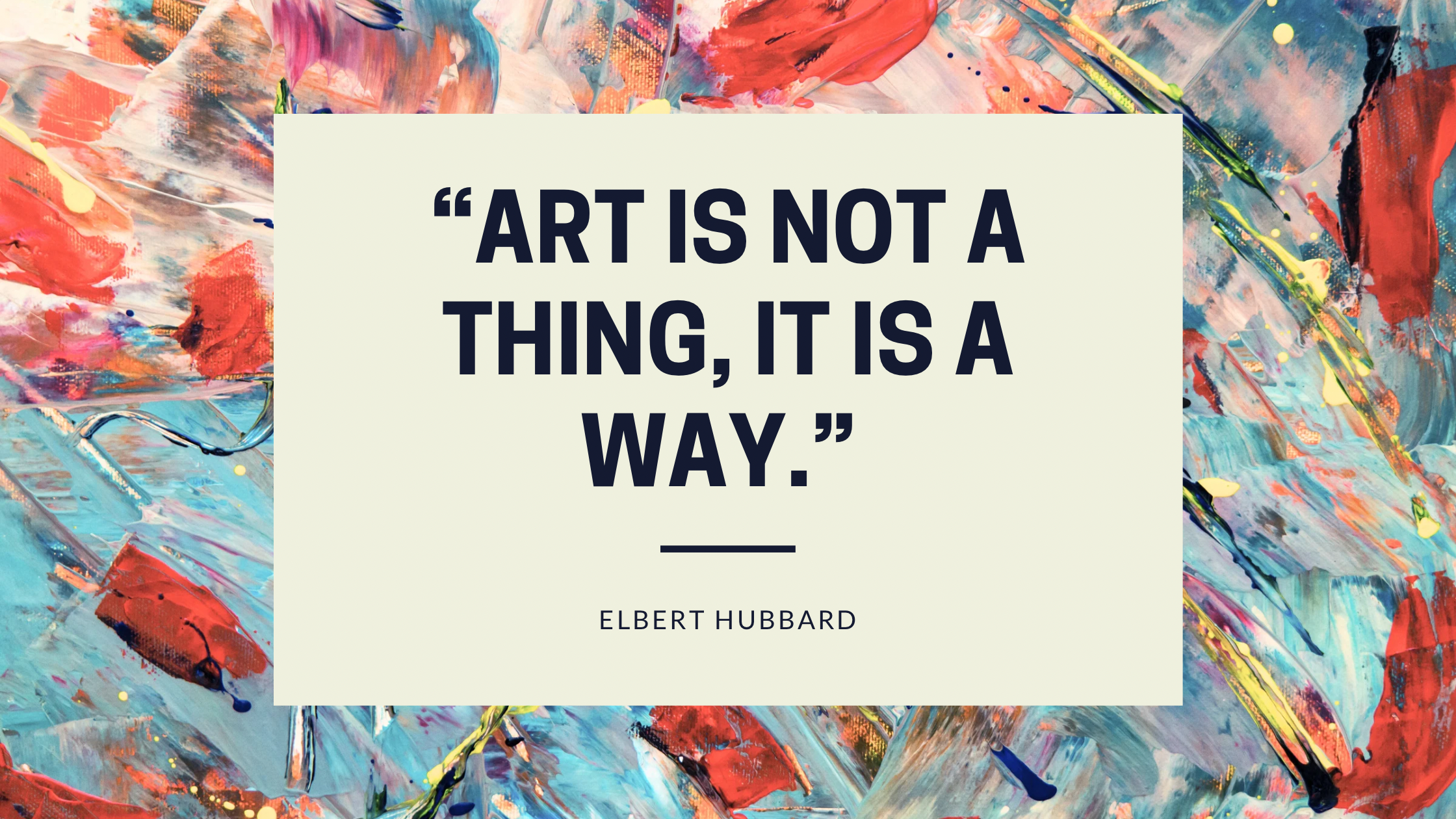Being an Art Detective
What is an art detective?
“Elementary, my dear Watson”
Embodying an art detective is a really fun and engaging way for us to think critically about art. Oh, and did we mention that at Raleigh Kids Art Gallery, it’s fun?? We make this time special. First, I put on my trench coat and detective hat, grab my magnifying glass, and turn on the Pink Panther theme song. Next, we pass around the magnifying glass to ask or answer questions about the piece we are looking at that day. Sometimes we use prompt questions based on our question dice, and other times, we sit with the artwork and come up with our own questions. Some days, we do both!
What questions do we ask?
We are all pretty familiar with question words: Who, What, Why, Where, When, and How. But how do we use those question words when talking about art? Really the sky's the limit, but here are some examples.
Who is the artist?
What do I feel when I look at the art?
Why was it made?
Where is the artist from?
When was this piece made?
How would I describe this artwork to my best friend?
BONUS QUESTIONS: Do I like it? If I could climb in this artwork, what would I feel, smell, hear, etc.
Compare and contrast:
A few times, we have made Venn diagrams to compare and contrast different artists, artwork, or artistic genres. One of my favorite side-by-side comparisons has been Jen Stark and Piet Mondrian. I really only ask what do we see that’s the same and what do we see that’s different. Kids never cease to amaze me with their insight and what they see that adults sometimes don’t!
Searching for Clues
When talking about art, it’s pretty common to hear “ugh, this is terrible!” or, the flip side, “I LOVE this one”. I like to remind everyone there is no bad art, but we definitely have preferences for what we like and dislike. This leads into even more conversations about what we like or dislike, specifically. Honestly, this is a hard question because sometimes we just have a bone-deep, visceral reaction to certain art. Sometimes, it just takes some time to figure out how we are feeling and why. Do we like the colors the artist chose? Maybe it’s the subject or the overall composition? Honestly, these are great questions to ask about so many different subjects, not just art!
Case Files:
Can I do this at home? The answer is a resounding YES! You can play games, ask questions, or even set up an art detective center in your home! All you need are some art prints, the questions dice or list, and maybe a magnifying glass for fun. With any art deck, you may want to double check that you feel comfortable with each print as a lot of classical art features nudity. As a note, none of these links benefit me in any way. I just want to share some of my favorite art detective resources. Let me know which one you try!
Who’s the artist game: https://www.eduweb.com/pintura/
Inside art game: https://eduweb.com/insideart/
Spot the difference art games: https://www.youtube.com/watch?v=z9Spi3EKycc
Art deck: https://www.quailridgebooks.com/book/9781579129651
Question dice: https://www.cityoflondon.gov.uk/assets/Things-to-do/make-your-art-detective-dice.pdf
Detective questions: https://theartofeducation.edu/wp-content/uploads/2015/10/Art-Detectives-Download.pdf
Embracing the role of an art detective transcends mere observation; it becomes a dynamic engagement with creativity. At Raleigh Kids Art Gallery, the experience is not only educational but imbued with joy and excitement. Equipped with a detective's gear and fueled by curiosity, children delve into the world of art armed with questions. From deciphering an artist's motivations to exploring personal reactions, every query unlocks a new perspective. Through comparisons, discussions, and playful exploration, young art enthusiasts uncover the nuances of expression and develop a deeper appreciation for artistic diversity. As they navigate through case files and embark on artistic adventures, the journey of discovery extends beyond the gallery walls, inviting them to cultivate their detective skills at home. With resources ranging from interactive games to thought-provoking question sets, the pursuit of art becomes an endless quest for insight and inspiration. So, don your detective hat and join the investigation – because in the world of art, every stroke tells a story waiting to be unraveled.
Embracing Creative Freedom: A Unique Approach to Kids' Art Classes
We believe that every child is a born artist, endowed with boundless creativity and imagination waiting to be unleashed. Read on to learn how we've crafted a unique approach to kids' art classes in Raleigh that prioritizes small class sizes and fosters an environment of creative freedom.
Here at Raleigh Kids Art Gallery, we believe that every child is a born artist, endowed with boundless creativity and imagination waiting to be unleashed. That's why we've crafted a unique approach to kids' art classes in Raleigh that prioritizes small class sizes and fosters an environment of creative freedom.
Small Class Sizes: Cultivating Connection and Individual Growth
In a world where classrooms often overflow with students, we've intentionally kept our kids’ art class sizes small. Why? Because we understand the importance of fostering meaningful connections and providing individual attention to each and every young artist who walks through our doors.
In our cozy studio space, children aren't just students; they're part of a close-knit community where their voices are heard, their ideas are valued, and their talents are celebrated. Our instructor acts not only as a teacher, but as a mentor, guiding each child on their artistic journey with personalized support and encouragement.
Room for Creative Freedom: Nurturing Exploration and Expression
We believe that art is about more than just following instructions or replicating a predetermined image. It's about exploration, experimentation, and, above all, self-expression. That's why we provide our young artists with ample room to let their creativity soar.
In our kids’ art classes, there are no rigid rules or stifling templates. Instead, children are encouraged to explore a wide range of artistic mediums, from painting and drawing to sculpting and mixed media. Whether they're creating a whimsical masterpiece or delving into the world of abstract expressionism, we celebrate each child's unique artistic voice and vision.
A Sanctuary for Young Artists to Thrive
We're more than just an art studio – we're a sanctuary for young artists to thrive. In an environment where mistakes are embraced as opportunities for growth and where creativity knows no bounds, children discover the joy of self-expression and the power of their own imaginations.
So, if you're looking for a place where your child can not only learn the fundamentals of art but also embark on a journey of self-discovery and creativity, look no further. With our small class sizes and a commitment to fostering creative freedom, we're dedicated to helping every young artist unlock their full potential. Join us in celebrating the transformative power of art and imagination – because here at Raleigh Kids Art Gallery, creativity knows no limits!
Think Like an Artist
I really love this quote by Elbert Hubbard, but I don’t necessarily agree with it. Or, well, maybe I should say I don’t think it’s expansive enough. Art is a process, Art is something that is created, and Art is a way of thinking. Read on to learn how we help children “think like an artist” every day during our track out art camps and classes.
Art often starts with an idea, but what even is an idea and how do we turn that idea into art? These big questions are the foundation for thinking like an artist. A few of the topics I focus on to grow creativity and problem solving in the classroom are brainstorming, researching, troubleshooting, and collaborating.
Brainstorm: “I don’t know what to make!”
When a student says they don’t know what to make, I usually ask what they like or are interested in that day and what materials they’re feeling drawn to. Nine times out of ten, they’ll yell “OH!” and go gather the supplies to start their project.
Some days, however, a student may need a little more direction. We all have days like this, even professional artists! One tool we use in this circumstance is a random idea generator. I have different baggies filled with idea cards titled color, season, subject (animal, tv show/video game/book character, fairy, etc.), location (mountains, ocean, forest, outerspace, etc.), and action (reading, playing an instrument, eating, etc.). They will draw from each baggy and lay out what they get. Maybe they get white winter fairy snowboarding in the mountains. Or maybe it’s a pink panda having a picnic in outer space! Whatever it is, they can choose to use those themes or draw others to make a different theme. More often than not, the cards serve as a springboard for original ideas!
Research: “I have an idea, but what now?”
Our next step is research. I include planning in this category as they tend to go hand in hand for me. This process looks different from student to student, but often includes looking at work made by professional artists, doing mini sketches of elements they want to include in their project, or looking for the colors and materials they want to use.
Troubleshoot: “This isn’t going the way I’d hoped.”
Troubleshooting is defined as discovering why something does not work effectively and making suggestions about how to improve it. What a vital and versatile skill to build! What do we do when our project isn’t turning out the way we’d imagined and planned? What happens when glue or paint gets spilled on your project? How do we fix our project if it won’t stand up properly, the color isn’t right, or the whole thing just feels off? Practically speaking, I usually start by complimenting their work because, I mean, have I mentioned how much I love kid art?? Then I ask what they don’t like or what they feel like is not going well. That usually leads to more conversation and sometimes suggestions. Sometimes we step away for a snack and come back with fresh eyes!
This is a skill that extends outside of the art classroom! Practicing troubleshooting can help kids think through the next steps of their tricky homework or what to do if they spill cereal on the kitchen floor.
Collaborate: “Should I make this out of clay or paper?”
I cannot tell you how many times a child has asked me a question like this and another student answers instead. I’ve found that kids love to teach and help each other. As often as possible, I sit back and let the kids help each other. Pablo Picasso and George Braque are excellent examples of artistic collaboration: together, they created Cubism! They worked together, learned from each other, and were better artists because of it.
Creativity Takes Courage
It takes incredible artistic skill, passion, and practice for an artist to recreate a painting, drawing, or sculpture by a master artist. However, most assignments or projects do not allow a person to turn in art that has already been done. That is why cultivating creativity is just as important as building technical skill for an artist. The artist Matisse once said, “creativity takes courage” and, let me tell you, these kids have courage!
If you would like for your child to learn how to “think like an artist,” consider signing them up for one of our trackout art camps or children’s art classes. Not sure what the best fit for your child will be? Contact us today to discuss how we can best meet the needs of your child!
Choice-Based Art
At Raleigh Kids Art Gallery, we value choice-based art. Read on to learn about the differences between limited, moderate and abundant choices in the art classroom and why we do what we do!
Hi there! This blog will be the place where I’ll talk about a variety of art topics. Today I’d like to talk a little about artistic choices in the classroom AKA choice-based art.
“Allowing choice” or “choice based education” are terms that you may or may not have heard in regard to art education. Those terms might conjure up ideas of finger painting on walls or intentionally getting messy.
But what does “choice-based art” really mean? Overall, choice-based art values the product AND the process equally. There is a full spectrum of how much choice is utilized in any given classroom. Each one of these styles have a purpose and none of them are right or wrong!
Limited Choice:
Some art teachers prefer to have limited choice in the classroom. This often looks like having a set project with the subject and materials preset or extremely limited.
Moderate Choice:
A moderate choice classroom has more choice and could look like giving the students a theme, but allowing them to choose the materials and subject.
Abundant Choice:
An abundant choice classroom is mostly or entirely learner-led, with the educator supporting that learning with technical demonstrations and well organized centers.
Students Have Moderate to Abundant Choice at Raleigh Kids Art Gallery
Personally, and for camps, I like to switch it up, but lean towards moderate to abundant choice. Some days, we have set projects utilizing specific materials, but each learner picks the colors and composition for that project. On these days, we learn about individual artists and utilize aspects of their art and make it our own.
Other days, I have less parameters, but add maybe one or two limitations. For example, they can pick their own subject, materials, and colors, but it has to be a 3D project. And other days still, it is entirely learner-based. They design their own project and complete it with whatever materials they want to use. I am there to help brainstorm ideas, troubleshoot problems, and encourage creativity. I hot glue A LOT on these days!
Each amount of choice has a purpose and encourages creativity and agility, while also building technical skills. This type of critical yet creative thinking has real world applications while remaining accessible and FUN! If you want your child to value the process just as much as they value the final product, contact me today to determine the best way to reach your child. Whether in afterschool art class, trackout art camps, or teacher work day camps, I am confident we can find a way to teach your child to explore their creative side in a whole new way!
You are welcome here!
“It took me four years to paint like Raphael, but a lifetime to paint like a child.” - Pablo Picasso
“It took me four years to paint like Raphael, but a lifetime to paint like a child.” - Pablo Picasso
Welcome to the Raleigh Kids blog!
I’m thrilled to embark on this creative journey with you all. Too often, our kids learn to be guarded and hesitate because they fear imperfections. But here, we’ll embrace so-called imperfections as a beautiful part of the creative process.
We will delve into various art forms, learning from their significance, art history, and the impact on the artistic world.
Thank you for joining me on this adventure. I’m so glad you’re here!









